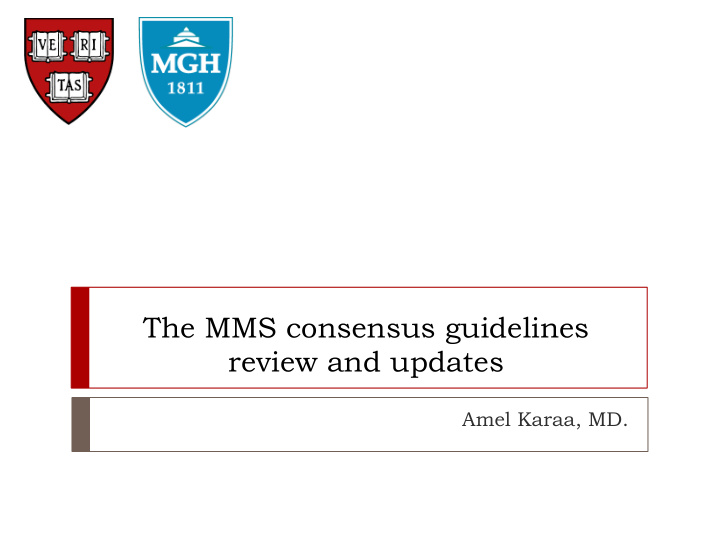



The MMS consensus guidelines review and updates Amel Karaa, MD.
Disclosures • President, Mitochondrial Medicine Society • Board member, Mitochondrial care network
Acknowledgement } Some slide are courtesy of Dr. Sumit Parikh
Optimizing Mitochondrial Disease Care } Practice Patterns, Challenges and Consensus Mitochondrion 2013 Genetics in Medicine 2015 Genetics in Medicine 2017
Optimizing Mitochondrial Disease Care v How is mitochondrial medicine practiced in North America? v Is there an optimal way of practicing mitochondrial medicine? v Is care standardized? v Who is in charge of care?
Mitochondrion 2013
Variability in diagnostic care Biochemical testing protocol Genetic testing protocol Muscle biopsy testing Interpretation of muscle biopsy Use of diagnostic criteria
Variability in treatment Use of supplements Cocktail vs no cocktail Monitoring of organ system involvement Monitoring lab work
Mitochondrion 2013
Results Similarities in practice but a general lack of consensus Agreement in care v Clinic structures and organization v Physician perceptions of various diagnostic laboratories v Care requires significantly more time v Shortage of adult trained experts
Establishing Consensus?
Methods to develop consensus } Evidence-based } Eminence based (grey heads in the room) } Committee based (may the strongest personality win) } NIH style consensus (non-experts decide) } Individual (I’ll decide) borrowed from Georgianne Arnold
Delphi Method “Pooled intelligence enhances individual judgement and captures the collective opinion of a group of experts”. Developing consensus in the absence of sufficient evidence utilizing a committee of content experts Literature Committee review and forms Survey Consensus? data subgroups summary Survey with Items group’s Discussion without Consensus? when needed responses consensus revealed
Genetics in Medicine 2015
US & Canada
Diagnostic Consensus Criteria Biochemical Testing in Blood, Urine and Spinal fluid Genetic Testing Pathology and Biochemical Testing of Tissue Neuroimaging Treatment of Acute Stroke Exercise Anesthesia Treatment During Illness Treatment with vitamins and supplements
Prevention and Care Guidelines
Genet Med 2017
Central Nervous System Audiology Abnormal tone Ataxia Sensorineural hearing loss Autonomic dysfunction Brainstem dysfunction Developmental disability Ophthalmology Epilepsy Cataracts Headaches Ophthalmoplegia Mood disorder Optic nerve atrophy Movement Disorders Ptosis Spasticity Retinopathy Strokes (metabolic) Cardiology Endocrinology Arrhythmia Adrenal insufficiency Cardiomyopathy Diabetes mellitus Conduction defects Growth hormone deficiency Heart block Hypoparathyroidism Hypothyroidism Osteopenia Pulmonology Short stature Apnea Aspiration Hypoventilation Gastroenterology Pulmonary hypertension Constipation Sleep Disorders Dysphagia Dysmotility Nephrology Failure to thrive Fanconi syndrome Liver dysfunction Glomerular dysfunction Pancreatic insufficiency Tubulopathy Pseudo-obstruction Immunology Hematology Recurrent infections Iron deficiency Pancytopenia Sideroblastic anemia Neuromuscular Myopathy Neuropathy Pregnancy Orthopedic Gestational diabetes Preeclampsia Contractures Preterm labor Fractures Scoliosis Systemic Psychiatry Exercise intolerance Mood Fatigue Anxiety
What’s new? v Who manages mitochondrial patients? v Where is their medical home? v Who will deliver these guidelines?
M i t o c h o n d r i a l c a r e n e t w o r k v Standardization and excellence of care v Improve quality and consistency of health services delivered v Improved care coordination v Clinical research and trial infrastructure v Facilitate Outcome and Natural History research fluidly
M i t o c h o n d r i a l c a r e n e t w o r k Preparation } Review of criteria used by most established centers of excellence for other diseases } Review of pitfalls and challenges } Establishing new network based on best practices for other organizations } Step-wise/staged execution
M i t o c h o n d r i a l c a r e n e t w o r k Planning } Focus groups of patients and families Families want multi-disciplinary care, better social support and care coordination } Survey from clinicians (93% support idea) } Input from Advocacy Groups (MitoAction, UMDF, FMM)
M i t o c h o n d r i a l c a r e n e t w o r k Selection Criteria } Clinic site based on number of patients, level of clinician experience, academic engagement and availability of comprehensive care resources } Physician-clinician driven with Patient Advocacy Group partnership } Governance Committee
M i t o c h o n d r i a l c a r e n e t w o r k
N E X T S T E P S ? v Creation of a Mitochondrial Care Network (MCN) v Announcement of Mitochondrial Medicine Centers
N E X T S T E P S ? An observational database of phenotype, genotype, and natural history. Supported by NIH, governed by physicians and scientists experts in mitochondrial disease 1343 patients (adults and children/males an females)
The changing paradigm in healthcare: From evidence-based medicine to value-based medicine } Effect of healthcare reform } Interventions and therapies are judged by payers and society by metrics of Value-Based Medicine } The effect of therapy on patient-centered outcomes = the incidence of disease complications, QOL, and survival vs. adverse events } Evidence-based medicine = The effect of intervention and therapies on surrogate markers, i.e., cholesterol in CAD strict glucose level in diabetes
On behalf of the MMS, Thank you!
Recommend
More recommend